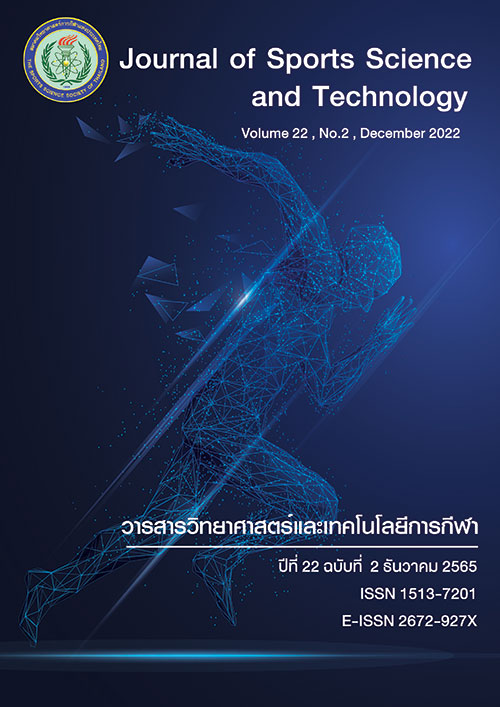VALIDITY AND RELIABILITY OF A DIGITAL INCLINOMETER IN ANKLE JOINT POSITION SENSE ASSESSMENT
DOI:
https://doi.org/10.14456/jsst.2022.16Keywords:
Digital Inclinometer, Intra-Rater Reliability, Inter-Rater Reliability, Joint Posistion Sense, AnkleAbstract
The ankle joint position sense is crucial for human movements. To date, several measurement tools have been used in assessing joint position sense. However, they are mostly high-costly and involve a complex system demonstrating a major limitation to be used in the field. This study employed an affordable and portable digital inclinometer to examine the angle of ankle movement in joint position sense testing. This study aimed to evaluate the criterion validity of the digital inclinometer, as well as intra- and inter-rater reliability of ankle joint position sense using a digital inclinometer. Twenty-one participants (23.86+3.98 years) without a history of lower limb injury were recruited. The ankle joint position sense was evaluated by two testers using a digital inclinometer that was attached to right dorsum of the foot to detect angle changes. The digital inclinometer’s criterion validity was examined by comparing the recorded degree of movement using an isokinetic dynamometer and a digital inclinometer. Dorsiflexion and plantarflexion angles were recorded by the digital inclinometer in the right ankle and used for intra- and inter-rater reliability analysis. Intraclass correlation coefficient (ICC) models were used to determine reliability.
The Bland-Altman plots demonstrated the point distribution within the interval to validate the digital inclinometer validity. The intra-rater reliability of the joint position sense test exhibited moderate in 1st rater (ICC 0.525-0.610), and poor in 2nd rater (ICC 0.398-0.478). Inter-rater reliability was poor agreement between two raters (ICC 0.43-0.48). The digital inclinometer can be considered as a valid, accurate, and portable tool for measuring the ankle range of motion, and ankle joint position sense in an individual rater. However, the multiple-rater reliability was poor to moderate. This low inter-rater reliability may be due to inaccurate placement of the inclinometer on the foot or a different level in the testing experience.
(Journal of Sports Science and Technology 2022; 2222 (2): 80-90))
(Received: 7 July 2022, Revised: 3 October 2022, Accepted: 12 October 2022)
*Corresponding Author: Ampika Nanbancha
College of Sports Science and Technology, Mahidol University, Nakhon Pathom, Thailand 73170
E-mail: ampika.nan@mahidol.edu
References
Schiftan GS, Ross LA, Hahne AJ. The effectiveness of proprioceptive training in preventing ankle sprains in sporting populations: A systematic review and meta-analysis. Journal of Science and Medicine in Sport. 2015 May 1;18(3):238–44.
Han J, Anson J, Waddington G, Adams R, Liu Y. The Role of Ankle Proprioception for Balance Control in relation to Sports Performance and Injury. Biomed Res Int. 2015;2015:842804.
Habelt S, Hasler CC, Steinbrück K, Majewski M. Sport injuries in adolescents. Orthop Rev (Pavia). 2011 Sep 6;3(2):e18.
Cho BK, Park JK. Correlation Between Joint-Position Sense, Peroneal Strength, Postural Control, and Functional Performance Ability in Patients With Chronic Lateral Ankle Instability. Foot Ankle Int. 2019 Aug 1;40(8):961–8.
Fu SN, Hui-Chan CWY. Are there any relationships among ankle proprioception acuity, pre-landing ankle muscle responses, and landing impact in man? Neurosci Lett. 2007 May 1;417(2):123–7.
Bertrand-Charette M, Dambreville C, Bouyer LJ, Roy JS. Systematic review of motor control and somatosensation assessment tests for the ankle. BMJ Open Sport & Exercise Medicine. 2020 Jul 1;6(1):e000685.
Bronner S, Agraharasamakulam S, Ojofeitimi S. Reliability and validity of electrogoniometry measurement of lower extremity movement. J Med Eng Technol. 2010 Apr;34(3):232–42.
Mohammadi F, Roozdar A. Effects of fatigue due to contraction of evertor muscles on the ankle joint position sense in male soccer players. Am J Sports Med. 2010 Apr;38(4):824–8.
Lee D, Han S. Validation of Joint Position Sense of Dorsi-Plantar Flexion of Ankle Measurements Using a Smartphone. Healthc Inform Res. 2017 Jul 31;23(3):183–8.
Romero-Franco N, Montaño-Munuera JA, Fernández-Domínguez JC, Jiménez-Reyes P. Validity and Reliability of a Digital Inclinometer to Assess Knee Joint Position Sense in an Open Kinetic Chain. J Sport Rehabil. 2019 May 1;28(4):332–8.
Vafadar AK, Côté JN, Archambault PS. Interrater and Intrarater Reliability and Validity of 3 Measurement Methods for Shoulder-Position Sense. J Sport Rehabil. 2016 Feb 1;25(1):2014–0309.
Ahmadi S, Uchida MC. Place of the gold standard isokinetic dynamometer in Paralympic sports: a systematic review. hm. 2021;22(3):1–10.
Ryan Splittgerber. Snell’s Clinical Neuroanatomy. 8th edition. Philadelphia: LWW; 2018. 560 p.
Gilman S. Joint position sense and vibration sense: anatomical organisation and assessment. Journal of Neurology, Neurosurgery & Psychiatry. 2002 Nov 1;73(5):473–7.
Portney LG, Watkins MP. Foundations of Clinical Research: Applications to Practice. 3rd edition. Upper Saddle River, N.J: Prentice Hall; 2009. 892 p.
jamovi - Stats. Open. Now. [Internet]. [cited 2022 Apr 13]. Available from: https://www.jamovi.org/
Franco PG, Santos KB, Rodacki ALF. Joint positioning sense, perceived force level and two-point discrimination tests of young and active elderly adults. Braz J Phys Ther. 2015;19(4):304–10.
García-Rubio J, Pino J, Olivares PR, Ibáñez SJ. Validity and Reliability of the WIMUTM Inertial Device for the Assessment of Joint Angulations. International Journal of Environmental Research and Public Health. 2020 Jan;17(1):193.
Mourcou Q, Fleury A, Diot B, Franco C, Vuillerme N. Mobile Phone-Based Joint Angle Measurement for Functional Assessment and Rehabilitation of Proprioception. Biomed Res Int. 2015;2015:328142.
S Edwards E, Lin YL, H King J, R Karduna A. Joint position sense - There׳s an app for that. J Biomech. 2016 Oct 3;49(14):3529–33.
Fraeulin L, Holzgreve F, Brinkbäumer M, Dziuba A, Friebe D, Klemz S, et al. Intra- and inter-rater reliability of joint range of motion tests using tape measure, digital inclinometer and inertial motion capturing. PLoS One. 2020 Dec 10;15(12):e0243646.
Silverson OA, Lemaster NG, Hettrich CM, Heebner NR, Uhl TL. Reliability and Validity of a Clinical Assessment Tool for Measuring Scapular Motion in All 3 Anatomical Planes. J Athl Train. 2021 Jun 1;56(6):586–93.
Pedley M. Tilt Sensing Using a Three-Axis Accelerometer. :22.
Chander H, Stewart E, Saucier D, Nguyen P, Luczak T, Ball JE, et al. Closing the Wearable Gap—Part III: Use of Stretch Sensors in Detecting Ankle Joint Kinematics During Unexpected and Expected Slip and Trip Perturbations. Electronics. 2019 Oct;8(10):1083.






